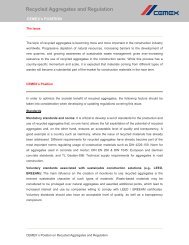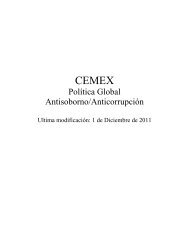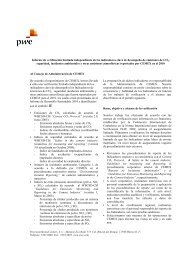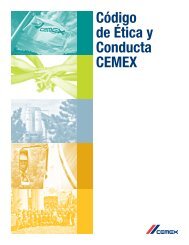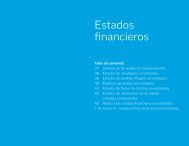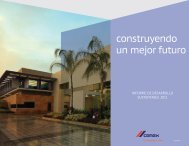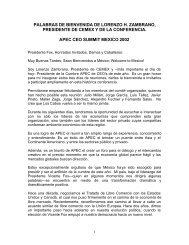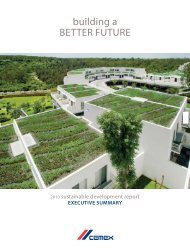building a STRONGER foundation - Cemex
building a STRONGER foundation - Cemex
building a STRONGER foundation - Cemex
You also want an ePaper? Increase the reach of your titles
YUMPU automatically turns print PDFs into web optimized ePapers that Google loves.
CEMEX, S.A.B. DE C.V. AND SUBSIDIARIES<br />
Notes to the Consolidated Financial Statements – (Continued)<br />
As of December 31, 2010, 2009 and 2008<br />
(Millions of Mexican pesos)<br />
As mentioned in note 2T, CEMEX accounted for its stock option programs in 2008 according to IFRS 2 and beginning on January 1, 2009<br />
under MFRS D-8, which provide basically the same accounting treatment. Effective January 1, 2006, under U.S. GAAP, CEMEX applies<br />
ASC 718, Compensation – Stock Compensation (“ASC 718”), which requires that all stock-based compensation be recognized as an expense<br />
in the financial statements and that such cost be measured at the fair value of the award. Similar to MFRS D-8 under MFRS, ASC 718<br />
requires liabilities incurred under stock awards to be measured at fair value at each balance sheet date, with changes in fair value recorded in<br />
the income statement. Likewise, MFRS D-8 and ASC 718 require compensation cost related to awards qualifying as equity instruments to be<br />
determined considering the grant-date fair value of the awards, and be recorded during the awards' vesting period. As of and for the years<br />
ended December 31, 2010, 2009 and 2008, the compensation expense and the liabilities accrued in connection with CEMEX's stock option<br />
programs under MFRS are the same amounts that would be determined using ASC 718 under U.S. GAAP.<br />
(j) Impairment of Long-Lived Assets<br />
Under U.S. GAAP, CEMEX assesses goodwill and indefinite-lived intangibles for impairment annually unless events occur that require more<br />
frequent reviews. Other long-lived assets, including amortizable intangibles, are tested for impairment if impairment triggers occur. Discounted<br />
cash flow analyses considering the required use of market considerations are applied to assess the possible impairment of goodwill and indefinite<br />
life intangible assets; whereas if impairment indicators exist, undiscounted cash flow analyses are used to assess the impairment for other longlived<br />
assets, including definite life intangible assets. If an assessment indicates impairment, the impaired asset is written down to its fair value<br />
based on the best information available. The useful lives of amortizable intangibles are evaluated periodically, and subsequent to impairment<br />
reviews, to determine whether revision is warranted. If cash flows related to an indefinite life intangible are not expected to continue for the<br />
foreseeable future, a useful life is assigned. Considerable management judgment is necessary to estimate undiscounted and discounted future cash<br />
flows. Assumptions used for these cash flows are consistent with internal forecasts and industry practices.<br />
As mentioned in note 2J, under MFRS, in order to test the balances of its long-lived assets for impairment, including goodwill, definite and<br />
indefinite life intangible assets and property, machinery and equipment, CEMEX determines the value in use, which consists of the<br />
discounted amount of estimated future cash flows to be generated by the related asset. The impairment loss results from the excess of the<br />
carrying amount over the value in use related to the asset. Differences in the carrying values of certain long-lived assets under U.S. GAAP as<br />
well as other factors explained below led to different impairment losses or impairment testing results between MFRS and U.S. GAAP. As of<br />
December 31, 2010 and 2009, CEMEX has no indefinite-lived intangible assets other than goodwill under both MFRS and U.S. GAAP.<br />
As mentioned in note 11B under MFRS, during the last quarter of 2010, 2009 and 2008, CEMEX performed its annual goodwill impairment<br />
test. Based on these analyses, in 2010, CEMEX determined an impairment loss of goodwill for approximately Ps189 (US$15) associated with<br />
the reporting unit in Puerto Rico, whereas, in 2008, goodwill impairment losses were determined for the United States, Ireland and Thailand<br />
reporting units for approximately Ps18,314 (US$1,333), including an impairment loss related to CEMEX’s Venezuelan investment in<br />
connection with its nationalization. For the year 2009, based on its goodwill impairment tests, CEMEX did not determine impairment losses<br />
of goodwill under MFRS. Likewise, considering triggering events in the United States during the fourth quarter of 2008, CEMEX tested its<br />
intangible assets of definite life in that country and determined that the net book value of certain trademarks exceeded their related value in<br />
use and recorded impairment losses of approximately Ps1,598 (US$116) (note 11). In addition, as mentioned in note 10, for the years ended<br />
December 31, 2010, 2009 and 2008, CEMEX recognized impairment losses in connection with the permanent closing of plant and equipment<br />
in several countries for an aggregate amount of approximately Ps1,161 (US$92), Ps503 (US$38) and Ps1,045 (US$76), respectively.<br />
Goodwill<br />
Under U.S. GAAP, if the carrying amount of the reporting unit exceeds its related fair value, CEMEX should apply a “second step” process<br />
by means of which the fair value of such reporting unit should be allocated to the fair value of its net assets in order to determine the reporting<br />
unit’s “implied” goodwill. The resulting impairment loss under U.S. GAAP is the difference between the carrying amount of the related<br />
goodwill as of the valuation date and the implied goodwill amount. This process, in addition to differences in the determination of the riskadjusted<br />
discount rates under MFRS as compared to U.S. GAAP, as well as differences in the reporting units’ carrying amounts between<br />
MFRS and U.S. GAAP, originate, when applicable, different amounts of impairment losses.<br />
To establish the fair value of its reporting units under U.S. GAAP, CEMEX initially calculated their fair value by discounting the projected<br />
future cash flows using country specific estimated weighted average cost of capital as the discount rates, and by including and blending the<br />
allocated fair value estimates, on a basis of 60% discounted cash flows and 40% Operating EBITDA (Operating income plus depreciation and<br />
amortization) multiples. As additional reference to the fair value as determined and as deemed necessary, CEMEX compared other market<br />
value indicators, including fair value estimates based on the Guided Transactions Approach and Industry Multiples.<br />
The results of the impairment test performed as of December 31, 2010 under U.S. GAAP indicated that the carrying amount of the reporting<br />
unit in Puerto Rico exceeded its estimated fair value. In connection with its reporting unit in Puerto Rico, CEMEX did not perform the second<br />
step considering that the related goodwill was fully impaired in the first step test; consequently, and considering that there were no differences<br />
in the goodwill balance of this reporting unit between MFRS and U.S. GAAP, there is no reconciling adjustment to the impairment loss<br />
relating to this reporting unit determined in 2010. As of December 31, 2010, goodwill under both MFRS and U.S. GAAP associated with<br />
CEMEX’s reporting unit in Puerto Rico was completely removed, as a consequence of an impairment of Ps189 (US$15).<br />
F-73



